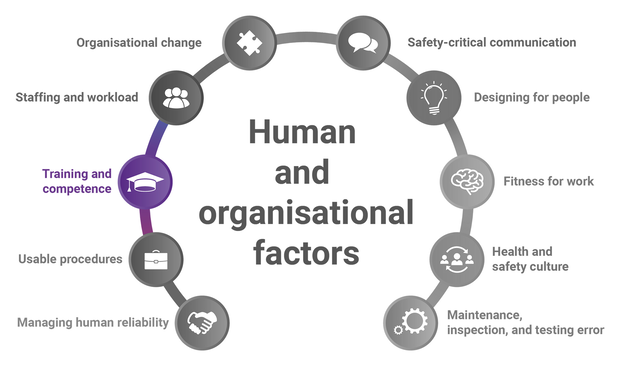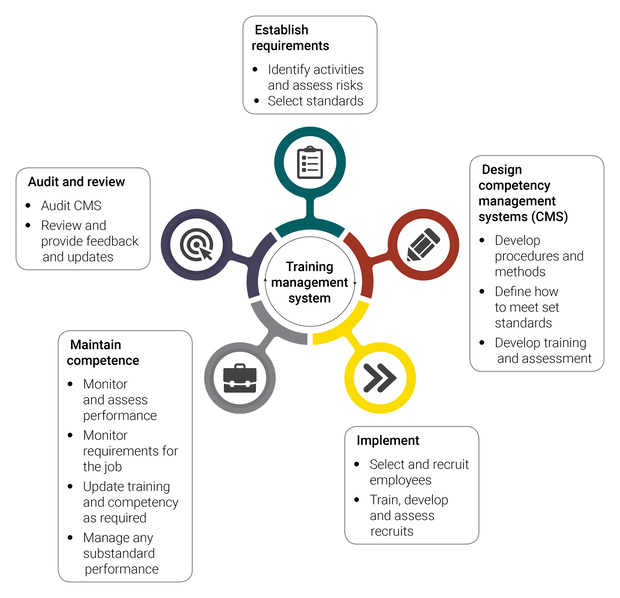
What is competence?
Competence is the combination of skills, experience and knowledge required to undertake the responsibilities of a role and consistently perform activities to a recognised standard on a regular basis.
Workers should be competent in their day-to-day tasks and also in health and safety matters such as recognising hazards and risks at work.
Having competent staff is critical to running a safe operation. This includes being able to supervise contractor work to a level that can assure quality and safety.
The provision of information, instruction, training and supervision is an essential component of any risk management strategy for ensuring the competency of workers.
What is training?
Training is a key component of ensuring that competency and consistency are achieved and maintained. It updates existing knowledge and skills, and provides people with new knowledge and skills.
However, in order to become competent, people need to apply and practice what they have learnt. Training and competence, collectively, can reduce errors caused by lack of knowledge and teach people behaviours that will keep them safe.
It is important to remember that this is not a universal safeguard, as even the most experienced and competent individuals can still make mistakes.
Training management systems
A training management system provides a framework for an organisation to define, develop, establish and maintain all training requirements across the organisation.
A robust training management system is fundamental to the safety of not only those conducting tasks, but also other workers and people who may be affected by their work.
Key steps in the development of a training management system are:
- establishing requirements
- designing the competency management system
- implementation
- maintaining competence
- auditing and review.
Considerations for effective management of training
Aspects of training that need to be considered to achieve competence include:
- selection of workers
- training purpose and needs
- skill acquisition/learning styles
- skills consolidation
- assessment
- evaluation.
When recruiting personnel, develop a clear understanding of the skills and experience required to fulfil the vacant role. The more detail that can be provided to applicants prior to employment, the better for both them and the organisation. This enables them to determine for themselves whether they believe they would be suited to and willing to fulfil the role. It also assists applicants to demonstrate they have the skills and knowledge to fulfil the role.
Task analysis can be a useful tool for determining all the requirements of a job, including competency-related matters, as well as functional capacity. It can assist in identifying any gaps in new recruits’ skill sets which the organisation will then need to be willing to address. If the organisation does not have the resources to address skill deficits to achieve competency, then they need to reconsider their recruitment decisions.
To ensure additional risks are not introduced through the recruitment process, an analysis to determine the number and type of staff required, using risk assessments, company policies and best practice to inform the analysis should be conducted.
Determine training needs
Organisations should conduct a training needs analysis to determine the training requirements for individuals, roles, teams, departments, etc. It is beneficial to develop individual training plans for all workers, identifying their specific training needs at different stages of their work lifecycle.
It should be noted that training should not be used to try and overcome poor design elsewhere; for example, developing ‘work-arounds’ to compensate for poor design of workplace, tools, equipment or procedures.
Consider the purpose of the training
Consider whether training is:
- initial information, such as familiarisation of the environment and systems
- ‘refresher training’ to maintain skill levels
- mandatory due to an operational change (e.g. new equipment)
- related to a change of job role
- in health and safety, rather than job-related skills training
- to develop non-technical skills, such as team-building, time management or conflict resolution
- to teach infrequently used, but critical, skills and knowledge such as emergency drills and error recovery
- for permanent employees, contractors or temporary staff.
The means by which individuals prefer to learn, or find that they learn most effectively, differs between people. This is why it is important to maximise learning by catering for different learning styles when designing training courses or programs of skill development.
Use suitable training method/s
Identify the best method for training delivery and consider what resources may be needed. Training participants are not likely to retain all of the information that is shared with them during a classroom-based education session. It is important to provide multiple modes of information delivery (i.e. visual, auditory and kinaesthetic), so as to appeal to a range of learning styles and preferences. This increases information retention and enhances people’s ability to apply the knowledge that they have acquired to the real world.
The following questions can assist when developing training.
- Are exercises or drills appropriate?
- Would simulations be beneficial?
- What is the best environment to learn in?
- Who will deliver the training and are they competent, knowledgeable and credible?
- Does there need to be a buddy system after training for further on-the-job observation?
- Is the training consistent with current procedures?
- Do you need specific work groups to attend together to simulate real working situations?
- What is the ratio of attendees to trainer?
- Is there opportunity to learn vicariously before having a go first hand?
On completion of training, a skills consolidation period should apply. This is so the learner can gain experience and reinforce the skills learned, prior to being assessed or undertaking the task. Through practicing on the job, learners are also given the opportunity to ask more questions after having applied their skills.
During the skills consolidation period, the learner may complete the specified trained job tasks unaccompanied or with supervision and their performance should be monitored.
Some training may require a formal assessment to validate competence against an agreed standard. This may include tests, assignments, on-the-job observations or follow-up observations. By developing consistent standards to measure against, organisations can ensure that training achieves its objectives.
It is important to assess more than just the job-specific skills. Hazard awareness, safety attitude and behaviour should also be considered as the ability to identify any shortfalls in a worker’s everyday performance may suggest a lack of competence with regard to risk management or hazard awareness.
Following completion of training, confirm that the worker understands the next steps in the training program and whether they are immediately authorised to perform new tasks, or if they require more training or supervision before undertaking specific tasks. Within the training management system, there should be provision for ongoing and regular review of worker competence, such as refresher training, and this should be communicated to the worker.
As part of a safe system of work, it is essential that training and assessment records are maintained and easy to access. In particular:
- supervisors need to be able to access workers’ training and assessment records to confirm a worker is competent before assigning tasks
- workers should be able to access their own training records so that they know what they are deemed competent in.
Communication and feedback is essential for effective training and can add value in determining the level of competence achieved.
All parts of the design, development and implementation of the training and assessment should be formally monitored and reviewed. Monitoring and review may include:
- peer reviews of delivery
- feedback forms from attendees
- task observations
- spot checks of completed training and assessment material.
The Department recommends an audit is conducted on the training management system at least every two years to ensure the operation is meeting its own system requirements as well as legislative requirements.
Additional evaluation of the effectiveness of the training management system should take place after an incident and the outcomes used to improve and close gaps within the system.
Resources
|
This webpage by DMIRS discusses considerations for training management systems, including training needs analyses, units of competency, record keeping and evaluation. |
|
|
What is the importance of training, information and instruction? |
This DMIRS webpage provides information on training including the relationship between training and competency and requirements for becoming a trainer or assessor. |
|
This webpage by DMIRS discusses various types of inductions, including site, area-specific and visitor inductions. |


